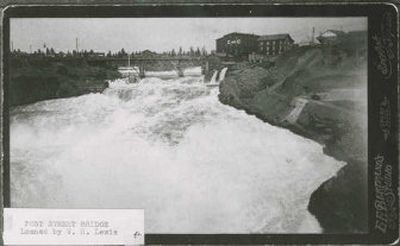Pioneer bridges

The announcement that the Monroe Street Bridge will reopen in September prompted this question from a reader: When did the first bridges cross the Spokane River?
The short answer: 1864 in the Spokane Valley flats, and 1881 in Spokane proper.
For the previous centuries, the river was a wet and wide barrier for anyone who wanted to travel from south to north (and back) in the Inland Northwest.
Here’s what Father Joseph Cataldo, early Jesuit missionary, said about Spokane Falls in the 1870s: “A little rope ferry and a couple of canoes offered the only means of passing over the swift stream.”
Until the mid-19th century, fording the river was the only option. The river had several traditional Indian fording spots, including the Winding Ford, near the present Long Lake Dam, and another well-used ford upstream near what is now Trentwood.
That’s near the spot where Antoine Plante – part-Flathead, part French-Canadian fur trader – launched Plante’s Ferry around 1856, the river’s first ferry. It was used by Capt. John Mullan as part of the Mullan Road in 1861 and 1862. The site is now Plantes Ferry Park.
Yet Plante’s Ferry already was in danger of becoming obsolete in 1864. That year, a couple of enterprising settlers threw the first bridge across the river, about nine miles upstream, almost on the present Idaho line. It was called Spokane Bridge (later Old Spokane Bridge), and it was impressive. It was 12 feet wide, covered with thick planks and made of big log beams. The little town of “Spokane Bridge” soon grew up around it, and in 1867 it became the first town in the area with a designated post office.
It wasn’t until about 1879 that the little town of Spokan Falls, about 20 miles downstream, began to grow. By 1881, “a little rope ferry and a couple of canoes” were hardly enough. A subscription was raised to build a bridge in town.
So the city’s first bridge, the original Howard Street Bridge, was quickly built that same year. The Howard Street Bridge was actually three bridges – Howard, Havermale and Washington – because it zigzagged across a couple of islands and ended up at Washington Street. It opened Sept. 7, 1881.
Many more bridges followed soon after. The first of many Post Street bridges, spanning the narrowest part of the gorge, opened in 1883, and the Division Street Bridge opened in 1888.
That also was the year that the first Monroe Street Bridge, made of wood, was built. It survived the 1889 fire and was rebuilt with steel in 1891. Then in 1911 it was redone in the familiar concrete form we know today.
So the next time you complain about a traffic jam on of the city’s bridges, think about those days when you had to drag yourself across on a rope ferry. At least today, you’re not likely to get wet.
(Most of the above information comes from three main sources: “The Spokane River: Its Miles and History,” by John Fahey in collaboration with Bob Dellwo; “Spokane’s Building Blocks,” by Robert B. Hyslop; and “The Old Fords, Ferries and Bridges on the Spokane River,” a newspaper article by C.S. Kingston in The Spokesman-Review, Sept. 6, 1953.)
The Lewis and Clark Report: 200 years ago this week, the Lewis and Clark Expedition was nearing the upper reaches of the Missouri River, close to what is now Great Falls.
They were heading up to a spot on the river that Meriwether Lewis, in his journal of July 19, describes as a majestic canyon with “black granite below” and a “much lighter color above.”
“From the singular appearance of this place, I called it the gates of the rocky mountains,” wrote Lewis.
The spot is now part of the Gates of the Mountains Wilderness Area, not far from Helena.
Meanwhile, William Clark reported a common July scourge: “Musquitors verry troublesom.”
100 years ago this week: The July 17, 1905, edition of The Spokesman-Review reported that “the past 10 days have produced more violent deaths than almost any other similar period in the history of Spokane.”
A man killed his wife and child and then committed suicide; the body of a murdered man was found in the Spokane River; two men drowned while swimming in the river; a “well-known insurance agent” shot himself in a secondhand store; and “Blind Dan” Cavanaugh, a well-known Spokane newspaper vendor, jumped off the Post Street Bridge.
“We heard someone yell, ‘Goodbye, Spokane,’ in a foghorn voice,” said a witness. “We looked up and saw a man jump from the edge outside the railing.”
Earlier that evening, he had left a saloon with these words: “Goodbye, I will see you in hell.”
Yet another death, this one in Wallace, was recounted earlier that week.
“Verna Weeks committed suicide at 10:30 tonight by taking carbolic acid,” said the article. “She was an inmate of a resort in the red light district and … was about 20 years of age.”
She had received a letter that morning from her sister in Spokane, “censuring her for the life she was leading, and this is what prompted her to commit suicide.”
The headline: “REMORSE OF A WAYWARD GIRL.”